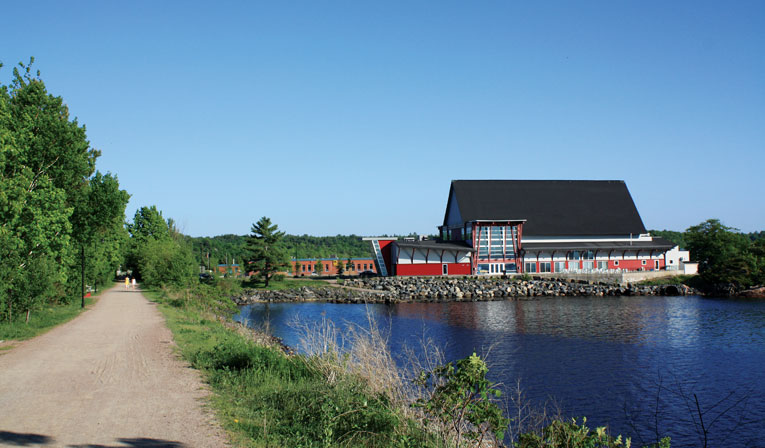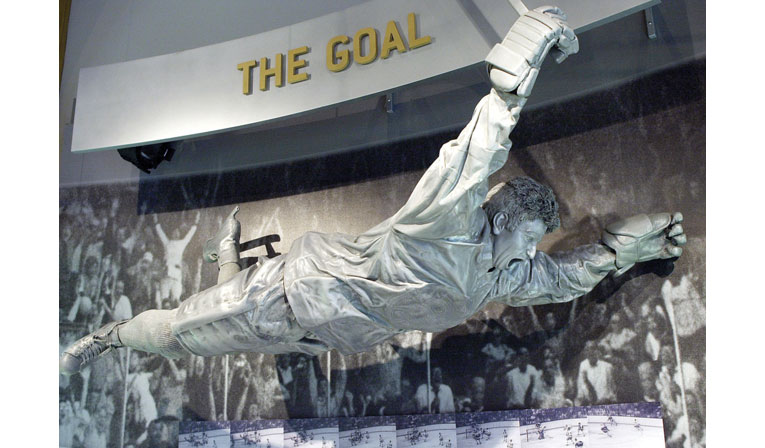Photo by Rolf Hicker Photography/hickerphoto.com
The town of Parry Sound is the world-renowned jewel of Georgian Bay’s 30,000 Islands.
What is it that a hockey super star, million-dollar paintings and Marilyn Monroe all have in common? The surprising answer is the little town of Parry Sound, Ontario.
Tucked into a fjord-like setting on the east shore of Georgian Bay, Parry Sound, with its population of 10,000 to 12,000 (depending on where you draw the boundary) is often described as Ontario’s “gateway to the north.” To its south lie Ontario’s largest cities, its busiest highways and its lushest farmlands, while to its north a landscape of harsh rockland, limitless lakes and twisted trees stretch to the Arctic watershed.
But Parry Sound is also the gateway to the world’s most extensive freshwater archipelago, the 30,000 Islands. A UNESCO World Biosphere Reserve, the collection of rounded pink islands, shoals and outcrops stretches the entire east coast of Georgian Bay and takes in an area of 347,000 square kilometers. This labyrinth of channels and hidden shoals has also sent many ships to a watery grave. It has also attracted hundreds of painters. One group, known as the Group of Seven, spent the early decades of the 20th century painting the waves, the wind bent pines and the rugged rocky shoreline. Paintings by members such as Lawren Harris, J.E.H. MacDonald and Franklin Carmichael now fetch millions at auction.
Humble beginnings
Parry Sound, however, started off modestly enough when, in 1857, William Gibson built a sawmill beside the sheltered harbor. Before that only the nomadic Huron and Ojibwa tribes travelled the region. French explorers like Samuel de Champlain and Etienne Brule poked around in the 1600s, but found no reason to stay. It was only after the vast forests of southern Ontario had become exhausted by the 1840s that lumbermen cast their collective gaze on the timbered shores of Georgian Bay.
In 1864 William Beatty bought up Gibson’s holdings and laid out a townsite beside the Seguin River, naming it Parry Sound after the legendary Arctic explorer William Edward Parry. A staunch Methodist, Beatty tolerated no liquor in his town. As a result, a raucous little community grew on the opposite shore of the river where the noise and bedlam from its many taverns earned it the sobriquet of “Parry Hoot.”
Parry Sound began isolated and remained so for many decades. In its early years, its only links to the rest of Ontario were by steamers or stagecoaches, which rattled along a rugged pioneer road known as the Great North Road.
It wasn’t until 1895 that the first rail lines approached the town. But, even then, railway builder John Rudolphus Booth bypassed Parry Sound, choosing instead for his terminus a sheltered harbor on nearby Parry Island that was home to a band of Ojibwa. Here he built a town of his own, calling it Depot Harbour. On its streets were hotels, churches, schools and 110 homes. On the shore he added a coal dock, 24-stall railway roundhouse and two massive grain elevators, which provided western grain growers with their shortest and fastest link eastward to the seaports of the Atlantic.
Another dozen years passed after Booth finished his line before the Canadian Northern Railway, now the Canadian National Railway, entered town from the south followed the next year by the legendary Canadian Pacific Railway (CPR). So steep was the town’s setting that CPR was forced to cross the harbor with what is Ontario’s highest railway trestle.
A further half-century would pass before Ontario’s highway system made its way to the town. Today those roads have inevitably expanded into a four-lane limited access roadway known as Highway 400.

Photo by Jessie Langford/gbcountry.com
Cruising Club
The Great Lakes Cruising Club (GLCC) 2012 Rendezvous will be held in Parry Sound this July. If you are not a member, check out their website, www.glcclub.com. The club was founded more than 75 years ago for the purpose of sharing cruising information. As a GLCC member, you gain access to authoritative reports about the five Great Lakes and their connecting waterways and can participate in various events and social gatherings throughout the year.
Photo by Jessie Langford/gbcountry.com
Historic downtown
If you are arriving by boat, keep the CP Railway Bridge in front of you as you approach the harbor. To port, you can tie up at Big Sound Marina, offering great transient facilities in the heart of Parry Sound. The friendly dock staff will help you find fuel, accommodations and food. A boater’s paradise, you’ll find all marine services readily available in the immediate Parry Sound area.
Parry Sound’s small town main street is lined with historic, two-story brick shops, many of which are still family owned. The tall tower of the town’s post office dominates the street. The two historic railway stations still stand. That of the Canadian National Railway, a brick structure dating from the 1920s, is now a tourist information office, while the intriguing wooden station built by CPR in 1908 was converted into a popular art gallery. A cone-shaped roof that sits atop the former waiting room is a rare architectural style known as a “witch’s hat.” Both continue to serve as stops for VIA Rail’s popular Toronto to Vancouver train known as the Canadian.
Long gone are the lumber mills, warehouses and oil tanks. Today the landscaped water’s edge offers gift shops, walkways and a long pier, beside which bob sleek yachts and cabin cruisers, along with more utilitarian Coast Guard vessels.
Here, too, looms the 550-passenger cruise ship Island Queen, whose route takes it from the inner harbor through the “Hole in the Wall” rock formation to the outer reaches of the wave-washed Thirty Thousand Islands. Shorter day cruises last two hours, while a more leisurely afternoon trip extends for three hours. Dinner cruises take in some of the most magnificent sunsets that the Great Lakes can offer.
The most recent addition to the harbor front is the Charles W. Stockey Centre. This dual-purpose building includes the 450-seat Festival Performance Hall, which hosts the town’s annual Festival of the Sound, one of Ontario’s most popular summer music festivals. Its 2012 edition runs from July 18 to August 12.
But the centre also contains a tribute to Parry Sound’s most famous native son, hockey legend Bobby Orr. A defenseman with the Boston Bruins in the late 60s and early 70s, Orr once led the National Hockey League in scoring, and is considered to have been the best defenseman to ever lace on skates. Recurring knee ailments sadly cut his career short and he finished his playing days with the Chicago Blackhawks. The Bobby Orr Hall of Fame includes videos of his more memorable hockey moments, of which there were many, as well as sweaters, trophies and one of his Stanley Cup rings.
Breathtaking views
Because the town nestles between two steep valley walls, panoramic views stretch from each side. The most popular and spectacular is atop Tower Hill. This reconstructed fire tower stands 96 feet tall and consists of 131 steps. The fire tower is where the tower man would sit on warm, dry days scanning the area for any signs of smoke. The adjacent West Parry Sound District Museum offers a look into the town’s maritime history.
There is, however, another Parry Sound, and that is the “district” of Parry Sound. This territory, much like a county, extends both north and east of the town itself. To the east lie remnants of rugged pioneer trails like the Nipissing Road, where barns and ghost towns lie overgrown and old grave markers tell the tragic tales of early life and death on the difficult bush farms.
For more than a century after the town’s founding, no roads led northward into the district. The perilous archipelago discouraged travel even by steamer, and only a few ports struggled into existence. Rather, it was the rail lines which first connected northern Parry Sound district to the outside. Amid those rugged rocks, the Canadian Pacific Railway saw the tourism potential that the lakes and rivers offered and built their Bungalow Camp on the banks of the historic French River.
For centuries, the French River had been a main highway for nomadic aboriginal tribes and for the booming fur trade of the 18th and 19th centuries. In 1928 the CPR opened the camp with a lodge and string of cabins. Among its early guests were King George VI (of “The King’s Speech”) and the Queen Mother Elizabeth during their royal tour of 1939. But it was during the 1950s that the remote little camp began to lure many of Hollywood’s celebrities, who sought respite from their hectic pace or who came simply to “dry out” after bouts with drugs or alcohol.
One such visitor was “Zelda Zonk” an alias for glamour icon Marilyn Monroe. Although her untimely death occurred half a continent away, author and ghost chronicler Terry Boyle, in his book “Marilyn at the French,” offers that a blonde apparition which appears in cabin 15, Marilyn’s cabin, is the ghost of Monroe herself who felt this was the only place she could find peace. The renovated property, now known as Yesterdays’, continues to offer comfortable accommodations, although celebrity sightings have dwindled, even ghostly ones.
Another mystery involved the tragic sinking of the Waubuno. Before the arrival of the railways, coastal steamers provided the only life lines for Parry Sound and the other little lumber villages hidden amid the shoal-ridden coast. As a vicious late fall blizzard raged in 1879, the Waubuno, a 150-foot sidewheeler, slipped away from its dock in Midland into the early morning’s snowy darkness. Around noon later that day, loggers heard a distant distress whistle from somewhere over the water. The Waubuno was never seen or heard from after that mournful cry for help.
While the hull eventually came to rest amid the shoals south of Parry Sound, the fate of its crew and passengers remain an intriguing mystery. Today that wreck resides near the surface in a back channel near the aptly named Wreck Island and is easily visible from passing boats.
Another ghost is that of Booth’s railway town of Depot Harbour. For four decades, the busy grain port was the Georgian Bay terminus of Booth’s railway and later that of the Canadian National Railway. But in 1933, ice irreparably damaged a vital bridge in Algonquin Park. Suddenly, Depot Harbour’s sole reason to exist was severed. During World War Two the elevators burned to the ground; by the 1950s, Depot Harbour was a ghost town.
Following its demise, the town’s vacant houses, hotels, churches and schools were harvested for their lumber. Today, a winding lane leads across Parry Island and the Wauskasing First Nation land to the foundations and ruins of that once vital port. While most of the ruins are little more than foundations, the concrete walls of the old railway roundhouse rise like Roman ruins from the forest. The site is Ontario’s most extensive ghost town.

Photo courtesy of Georgian Bay County Tourism
Explore the outdoors
Across the channel from the ghost town stretches one of Ontario’s most popular parks, Killbear Provincial Park. Even with 880 campsites, the grounds are often fully booked. Most of those sites overlook the waters, and the smooth pink rocks of the Thirty Thousand Islands. Short hiking trails lead to a lighthouse, a lookout point and through a natural area.
Signs at the entrance to the park caution drivers to “brake for snakes.” That warning helps protect the endangered Massasauga rattlesnake. A sluggish snake with mild venom, it’s more likely to be stepped on than it is to attack. In fact, the last person to suffer a bite was trying to “help” the creature across the road.
What better way to absorb the beauty of the 30,000 Islands than to join the quickly growing popularity of kayaking. Close by the Park the White Squall Paddling Centre offers a vast range of kayaks and canoes along with instructions on how to safely use them.
Not too surprisingly, the archipelago has long been one of the most popular boating waters north of the Caribbean. Cabin cruisers, sailing yachts and vessels of all shapes and sizes probe the back channels and brave the open waters. Caution dictates that good navigational charts be close at hand while sudden squalls can turn the open waters into a churning cauldron.
Divers may explore the many wrecks found throughout the islands, as well as the waters around the abandoned fishing stations of the outer islands.
Landlubbers may enjoy one of the area’s half dozen golf courses, although the only bayside course is the Parry Sound Golf and Country Club just north of the town.
Don’t discount winters in Parry Sound. Although the long snowy season can be decidedly crisp, it also offers some of the best snowshoeing, cross country skiing and snowmobiling in Ontario. The most popular trails are those that follow Booth’s railway roadbed and are known as the Seguin Trail, and the Rose Point Trail. The same routes are busy in the summer as well with hikers and ATVs.
Back in Parry Sound, visitors who wish something other than chain restaurants and hotels that cluster along the highway will find plenty to choose from. A popular eatery can be found at the Log Cabin Inn, just south of town. This four-season hotel offers gourmet dining with a breathtaking view. It is the perfect location in the Georgian Bay region to experience luxury accommodations with a multitude of recreational activities in a pristine natural setting.
The Bay St. Café and Kudos Fine Dining, located on Bay Street, also offer dining with a view of the harbor.
If you are looking to experience a warm, friendly family resort, the award-winning Craganmor Point Resort is minutes from Parry Sound by boat, located on McLaren Island. You will find spacious waterfront cottages with a sandy beach, and their full menu restaurant is open to the public. Weekend and special fishing packages are also available. Book all seven cottages for a memorable family reunion or company team-building retreat.
Several smaller, family-style restaurants and pubs can be found throughout town.
For something completely different, hop a sea plane or go by boat to Henry’s Fish Restaurant, located on Frying Pan Island on the Georgian Bay coast. Henry’s is known for its famous fish and chips and pan-fried pickerel (walleye) dinners.
Local hospitality and elegant furnishings attract overnight guests to B&B’s such as the Bayside Inn, the 40 Bay Street Bed & Breakfast and the Trappers Choice Inn and Restaurant.
Parry Sound yields a visual natural treasure and small town friendliness few will forget.
And, oh yes, it is no longer “dry.”
Ron Brown is a travel writer and author of more than 20 books that explore ghost towns, rail lines, back roads and the many more unusual sights and attractions around Ontario. He lives in Toronto and has been a regular visitor to Parry Sound since the early 1960’s. Check out his website, ronbrown.ca.




